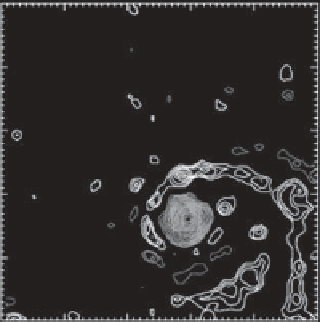Geoscience Reference
In-Depth Information
50
40
100
30
20
50
10
0
50
100
0
10
20
30
40
50
Figure 7.2.
Drift of monopolar cyclonic vortices over a sloping bottom topography in a rotating tank. Adapted from
Flór and
Eames
[2002]. See also Table 7.1. Left: Relative vorticity contours of a stirring vortex drifting in “northwest” direction. The central
core contains positive vorticity contours, whereas the surrounding negative vorticity is characteristic of this type of vortices. Right:
Same for a sink vortex, but now the negative vorticity around the vortex is generated only by the topographic
β
-effect. The vortices
are generated at the “southeast” (lower right) corner. The scale of both domains is in cm.
is given by (7.21). The use of a sloping bottom to mim-
ick the
β
-effect was originally developed by
Pedlosky and
Greenspan
[1967], and it was widely used in experiments
on the wind-driven ocean circulation or the intensifica-
tion and separation of western currents, among other
applications [
[Griffiths and Kiss
, 1992]. More recently, the
topographic
β
-plane has been used to study the motion
of vortices. A detailed derivation and discussion are given
by
van Heijst
[1994].
There have been numerous experimental studies on the
motion of monopolar vortices on a topographic
β
-plane
[e.g.,
Masuda et al.
, 1990;
Carnevale et al.
, 1991]. In
particular,
Flór and Eames
[2002] studied the motion of
barotropic vortices on the Coriolis platform. Following
Carnevaleetal.
[1991], the study of Flór and Eames exam-
ined the drift of two different cyclonic vortices, namely,
“sink” and “stirring” vortices. These names are associ-
ated with the generation methods and have been widely
explained in the reviews by
HopingerandvanHeijst
[1993]
and
van Heijst and Clercx
[2009]. Both structures are ini-
tially axisymmetric. On a flat bottom, sink vortices have
a single-signed vorticity and are hence nonisolated, while
stirring vortices consist of a core surrounded by an annu-
lus of oppositely signed vorticity in such a way that the
vortex contains zero net vorticity. The authors included
in their analysis an additional parameter
α
measuring the
steepness of the azimuthal velocity profiles.
Once generated, cyclonic vortices drift toward the
“northwest” direction, which corresponds with an uphill
motion with a leftward component. The northwestward
motion of sink and stirring cyclones depends on their dif-
ferent vorticity distribution and also on the steepness of
their corresponding profiles. Stirring vortices travel with
a pronounced northward trajectory, while sink vortices
driftmore in a northwest direction (Figure 7.2). This result
was already known from experiments in a medium-size
rotating tank by
Carnevale et al.
[1991]. The relevance of
the study by Flór and Eames in a larger container is that
quantitative measurements of the vortex structures, tra-
jectories, velocity, and vorticity fields can be obtained with
much higher resolution and detail. For instance, sink vor-
tices develop an enveloping patch of negative vorticity as
they drift, similar to the anticyclonic ring of stirring vor-
tices (see Figure 7.2). This patch is associated with Rossby
wave radiation due to the
β
-effect.
Another advantage of the large container is that it
allows the use of a very gentle slope (
s
0.053), in com-
parison with the more abrupt topographies used in smaller
containers by
Masuda et al.
[1990] and
Carnevale et al.
[1991]. A weaker slope improves the simulation of the
planetary
β
-effect, as illustrated in Table 7.1, where the
dimensional and nondimensional
β
values in the experi-
mental flows and in oceanic flow conditions are presented.
For the oceanic case, typical values of mesoscale vortices
at midlatitude are considered, which give a nondimen-
sional
β
≈
≈
0.01. The effective
β
parameter in the stud-
ies by
Masuda et al.
[1990] and
Carnevale et al.
[1991]
are overestimated by approximately a factor of 7 and 4,
respectively, while the parameter obtained in the large
platform (0.015) is much closer to the oceanic value.
7.3.2. Topographic Waves
For small-amplitude motions (e.g., in the wake of a
moving vortex), the planetary
β
-effect induces radiation
of so-called Rossby waves. These waves can be visualized

















